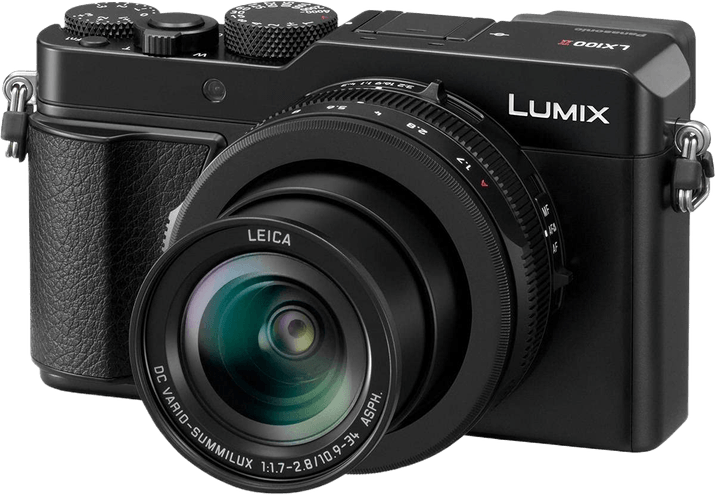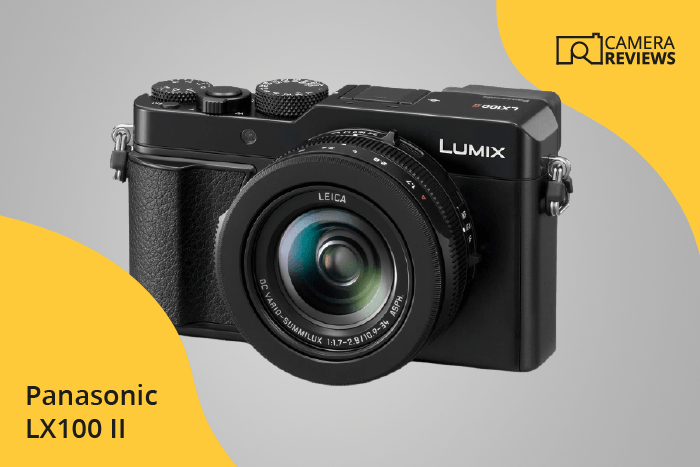Panasonic Lumix LX100 II Specs and Scores

The Panasonic Lumix LX100 II receives a score of 60/100. Announced on August 22, 2018, this compact camera entered the market at a price of $999. Measuring 115 x 66 x 64mm and weighing 392g or 0.86lbs, it is a lightweight and portable option. Considering its specifications, the Lumix LX100 II offers decent features for a 2018 release, but faces tough competition in today’s market.
Panasonic Lumix LX100 II Overview and Optics
The Panasonic Lumix LX100 II receives a score of 58/100 for its optics. This camera features 17 megapixels, an 11 fps shooting speed, and a CMOS sensor powered by the Venus Engine. Its DXOMARK sensor score stands at 71. Utilizing a Micro Four Thirds sensor size, the LX100 II is equipped with a fixed lens mount, making it impossible to change the lens. However, the camera does offer image stabilization and a 4:3 aspect ratio.
Compared to other cameras on the market, the Lumix LX100 II performs decently in terms of optics. The 17-megapixel resolution is not groundbreaking, but it is sufficient for everyday photography. The 11 fps shooting speed allows for capturing quick moments, while the CMOS sensor and Venus Engine ensure high-quality images. The fixed lens mount may be limiting for photographers seeking versatility, but the included image stabilization compensates for potential motion blur.
The Panasonic Lumix LX100 II is a solid choice for casual photographers. While it may not excel in every aspect of optics, it provides a reliable and user-friendly experience.
Panasonic Lumix LX100 II Video Performance
The Panasonic Lumix LX100 II obtains a video score of 69 out of 100. The camera supports a maximum video resolution of 4K, with dimensions of 3840 x 2160 pixels. This allows for high-quality video capture with a maximum frame rate of 60fps, ensuring smooth and detailed footage.
Despite the impressive specifications, the LX100 II lacks time-lapse functionality built-in, limiting its creative potential for videographers. Compared to other cameras in the market, the LX100 II’s video capabilities are competitive, but the absence of time-lapse features might deter some users.
The Panasonic Lumix LX100 II offers commendable video performance with its 4K resolution and 60fps frame rate. However, the lack of built-in time-lapse functionality may prompt potential buyers to consider alternatives with more comprehensive video features.
Panasonic Lumix LX100 II Features and Benefits
The Panasonic Lumix LX100 II receives a feature score of 70 out of 100, a respectable standing in today’s market. This camera comes with a 3-inch screen size and a screen resolution of 1240000 dots. The touchscreen capability enhances user experience and interaction with the camera.
However, the Lumix LX100 II lacks a flip screen, which might be a disadvantage for those who prefer different viewing angles. Additionally, it does not include GPS functionality, a feature that some photographers find useful for geotagging photos. On the other hand, this camera supports WIFI and Bluetooth connectivity, allowing users to transfer files and control the camera remotely with ease.
Taking these features into account, the Panasonic Lumix LX100 II proves to be a competitive option in the market, offering a balance of modern technology and practical functionality.
Panasonic Lumix LX100 II Storage and Battery
The Panasonic Lumix LX100 II receives a storage and battery score of 35/100. This camera has one memory card slot and accepts SD, SDHC, and SDXC cards, with UHS-I compatibility. Although a single slot is common in compact cameras, some users may prefer multiple slots for added storage flexibility.
The LX100 II has a battery life of 340 shots, which is average for cameras in its class. The battery type is DMW-BLE9, and the camera features USB charging. This provides convenience for charging on-the-go, but may not be sufficient for extended shooting sessions without spare batteries.
Overall, the Panasonic Lumix LX100 II offers average storage and battery capabilities. While it meets the basic needs of most users, it may not stand out in today’s competitive market.
Panasonic Lumix LX100 II Alternatives
Do you want to know how the Panasonic Lumix LX100 II compares to its competitors? Have a look at the most popular comparisons for this camera below:
- Panasonic Lumix DMC-LX100 vs Lumix LX100 II
- Panasonic Lumix LX100 II vs Sony Cyber-shot DSC-RX100 VII
- Fujifilm X100V vs Panasonic Lumix LX100 II
- Panasonic Lumix LX100 II vs Sony Cyber-shot DSC-RX100 VA
- Canon PowerShot G7 X Mark III vs Panasonic Lumix LX100 II
- Nikon Z6 II vs Panasonic Lumix LX100 II
Panasonic Lumix LX100 II FAQ
Does the Panasonic Lumix LX100 II Have Built-in Image Stabilization?
Yes, the Panasonic Lumix LX100 II features built-in image stabilization, which helps reduce camera shake and blur, resulting in sharper images and smoother video recordings.
Does the Panasonic Lumix LX100 II Support 4K Video Recording?
Yes, the Panasonic Lumix LX100 II supports 4K video recording at 30fps, allowing users to capture high-quality, detailed videos with ease.
What Size Sensor Does The Panasonic Lumix LX100 II Have?
The Panasonic Lumix LX100 II is equipped with a Micro Four Thirds sensor, providing excellent image quality and performance in a compact camera.
Does the Panasonic Lumix LX100 II Have a Dual Memory Card Slot?
No, the Panasonic Lumix LX100 II does not have a dual memory card slot. It features a single SD card slot for storage.
Does the Panasonic Lumix LX100 II Have a Touch Screen?
Yes, the Panasonic Lumix LX100 II features a touch screen, enabling users to navigate menus and settings easily and intuitively.
Does the Panasonic Lumix LX100 II Have Wi-Fi and Bluetooth?
Yes, the Panasonic Lumix LX100 II has both Wi-Fi and Bluetooth capabilities, allowing for easy wireless transfer of images and remote camera control via compatible devices.
Does the Panasonic Lumix LX100 II Have GPS?
No, the Panasonic Lumix LX100 II does not have built-in GPS functionality.
Is the Panasonic Lumix LX100 II Weather Sealed?
No, the Panasonic Lumix LX100 II is not weather sealed, so it is important to take precautions when using it in harsh weather conditions.
Does the Panasonic Lumix LX100 II Have a Built-in Flash?
No, the Panasonic Lumix LX100 II does not have a built-in flash. However, it does have a hot shoe for attaching an external flash if needed.

